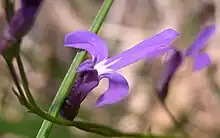Lobelia dentata
Lobelia dentata is a herb found in eastern Australia. The habitat is eucalyptus woodland and forest, often on sandy soils. It is an uncommon species, but may be locally abundant after bushfires.
| Lobelia dentata | |
|---|---|
 | |
| St Ives North, Australia | |
| Scientific classification | |
| Kingdom: | Plantae |
| Clade: | Tracheophytes |
| Clade: | Angiosperms |
| Clade: | Eudicots |
| Clade: | Asterids |
| Order: | Asterales |
| Family: | Campanulaceae |
| Genus: | Lobelia |
| Species: | L. dentata |
| Binomial name | |
| Lobelia dentata | |
| Synonyms | |
|
Rapuntium dentatum (Cav.) C.Presl | |
Lobelia dentata grows as a slender, hairless plant, growing to 40 cm (16 in) high. The flowers form on a raceme and appear from March to November. The dark blue or purple flowers are small, but create a spectacular sight with their abundance and beauty. The specific epithet dentata refers to the "toothed leaves". The leaves are 1 to 4 cm long, and 3 to 10 mm wide. The fruiting capsule is 4 to 7 mm long, and 4 mm in diameter.
The original specimen was collected by Joseph Banks and Daniel Solander at Botany Bay in 1770, when part of the first voyage of Captain James Cook.[1]
This plant first appeared in scientific literature in 1800, in the Icones et Descriptiones Plantarum, authored by the Spanish botanist Antonio José Cavanilles.[2]
The species ranges along coastal districts of New South Wales from Murwillumbah to Batemans Bay. It also occurs in Victoria. The habitat is eucalypt forest.
References
- "Backdrop to encounter: the 1770 landscape of Botany Bay,the plants collected by Banks and Solander and rehabilitation of natural vegetation at Kurnell. Authors: Doug Benson and Georgina Eldershaw" (PDF). Archived from the original (PDF) on 2009-10-04.
- Les Robinson - Field Guide to the Native Plants of Sydney, ISBN 978-0-7318-1211-0 page 186